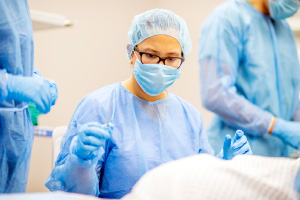Do Obstetricians Perform Surgery (What Kind)?
 In short, the answer is Yes. Obstetricians are physicians who can perform a variety of surgical interventions. They also manage everything related to labor and delivery, including providing counsel and prescribing or authorizing pharmaceutical prescriptions or OTC products.
In short, the answer is Yes. Obstetricians are physicians who can perform a variety of surgical interventions. They also manage everything related to labor and delivery, including providing counsel and prescribing or authorizing pharmaceutical prescriptions or OTC products.
Many OBs also are licensed gynecologists (OB/GYNs), making them experts in general women’s and pregnancy-related health matters. Both roles can provide surgical services.
However, some OB/GYN specialties require advanced surgical training. For example, urogynecological surgery is done by OB-GYNs with specialized knowledge of pubic floor reconstruction.
The four main types of specialties, or fellowships, of an OB/GYN include:
- gynecologic oncology
- reproductive endocrinology and infertility
- female pelvic medicine and reconstructive surgery
- maternal-fetal medicine
There are additional specialties like genetics, adolescence, and pediatric gynecology. Each one will offer more granular specialization in certain surgical practices.
Specialties like these run for three years following the completion of the four-year-long residency program. In other words, OBs have extensive training designed to assist a wide variety of pregnancy-related needs.
Common Types of Surgeries Performed by Obstetricians
 Inpatient procedures:
Inpatient procedures:
- Hysterectomy
- Sacrocolpopexy
- Myomectomy
Outpatient procedures:
- Laparoscopic tubal ligation:
- Loop electrosurgical excision procedure (LEEP)
- Dilation & curettage (D&C)
- Ovarian cystectomy laparoscopy
- Midurethral sling
- Endometrial radiofrequency ablation
- Hysteroscopy
Outpatient procedures aren’t as invasive or intense. As a patient, you will be counseled on the appropriate procedure long before it is suggested.
Hysterectomy Surgery
A hysterectomy is an invasive surgical procedure that removes the uterus and cervix. Women who suffer from fibroids or uterine prolapse should consider a hysterectomy. These can be a full hysterectomy or a partial one.
If the condition is something incurable, like cervical cancer, then a full hysterectomy is advised. If it’s something like endometriosis, heavy bleeding, or pelvic pain, then a partial hysterectomy is better. Only the uterus gets removed, not the cervix.
Myomectomy Surgery
It’s designed to remove fibroids from a woman’s uterus. This is a great option for women who intend to have children in the future and wish to opt out of a hysterectomy. The typical recovery time for this surgery is up to six weeks.
Dilation & Curettage (D&C) Surgery
This is an outpatient procedure that removes tissue from a woman’s uterus. The OB will dilate the cervix to expose the uterine opening; then, a curette is inserted into the dilated cervix to move near the cervix. It’s often used to clear the uterine lining after a miscarriage or abortion or to stop excessive vaginal bleeding.
Sacrocolpopexy Surgery
Sacrocolpopexy reconstructs the female sex organs by separating the vaginal walls from the bladder and rectum, then inserting a mesh that is Y-shaped to the vaginal walls to help the vagina return to its original position. Sacrocolpopexy surgery once required a six-inch incision across the abdomen. Today, there are far less invasive methods.
The providers at Northland Women’s Health Care always opt to use a minimally invasive approach first and foremost. The goal is to reduce recovery time from six weeks to somewhere between two and four weeks.
Loop Electrosurgical Excision Procedure (LEEP)
This unique procedure is used in two ways: as a diagnostic tool for abnormal cell growth and as a method of treatment for women with cancers in the lower genital tract, cervix, or vagina. It removes abnormal cells to make room for healthy ones. It can be used to treat cervical dysplasia and genital warts too.
LEEP works by using a thin wire loop to carry an electrical current that trims a thin layer of tissue; this tissue sample is then sent back to a laboratory and tested for cancer.
Ovarian Cystectomy Laparoscopy
This procedure is designed to remove cysts from a woman’s ovary. It consists of a few small incisions in the lower abdomen.
Laparoscopic Tubal Ligation
If you know you’re not going to have any more kids in the future and cannot afford the six-week recovery time associated with traditional tube ligation surgery, laparoscopic tubal ligation is probably the best option. Putting a laparoscope (a thin tube with a light and camera) within a small incision allows the obstetrician to view internal organs without opening the abdomen.
After doing this, tubal ligation ensues, a procedure in which fallopian tubes are blocked or severed to prevent eggs from getting to the uterus from your ovaries. Expect a recovery time of two or four weeks.
Midurethral Sling Insertion
Women who give birth to children find that their pelvic muscles weaken to the point where they cannot control urination. To address incontinence, a midurethral sling can be placed through the obturator canal to support the urethra. This outpatient procedure takes about 30 minutes to complete and isn’t very invasive nor requires general anesthesia.
Endometrial Radiofrequency Ablation
If you have a heavy period flow, endometrial radiofrequency ablation is recommended. It destroys the uterine lining and promotes lighter periods. Additionally, the radiofrequency heat destroys fibroids, making this procedure a less invasive alternative to traditional surgery.
Hysteroscopy
A hysteroscopy procedure uses a hysteroscope, which is a lighted tube that gets sent into the vagina to examine internal reproductive organs. This is a minimally invasive diagnostic procedure used to diagnose the cause of infertility or repeated miscarriages.
Some of its uses include identifying and removing polyps or fibroid tumors or preventing excessive bleeding by eliminating tissues. It’s often used as a confirmation for an initial X-ray dye test that is used to detect the general health of the uterus and fallopian tube. This is often used in combination with other procedures like D&C or laparoscopic ovarian cystectomy.
 Schedule Surgical Consultation with an Obstetrician in the Liberty area of Kansas City, MO
Schedule Surgical Consultation with an Obstetrician in the Liberty area of Kansas City, MO
If you’re suffering from pelvic pain or excessive vaginal bleeding, our incredible obstetricians at Northland Women’s Health Care can help. Our services assist you throughout pregnancy, from pregnancy planning to labor and even postpartum recovery. Call to schedule your first visit.
